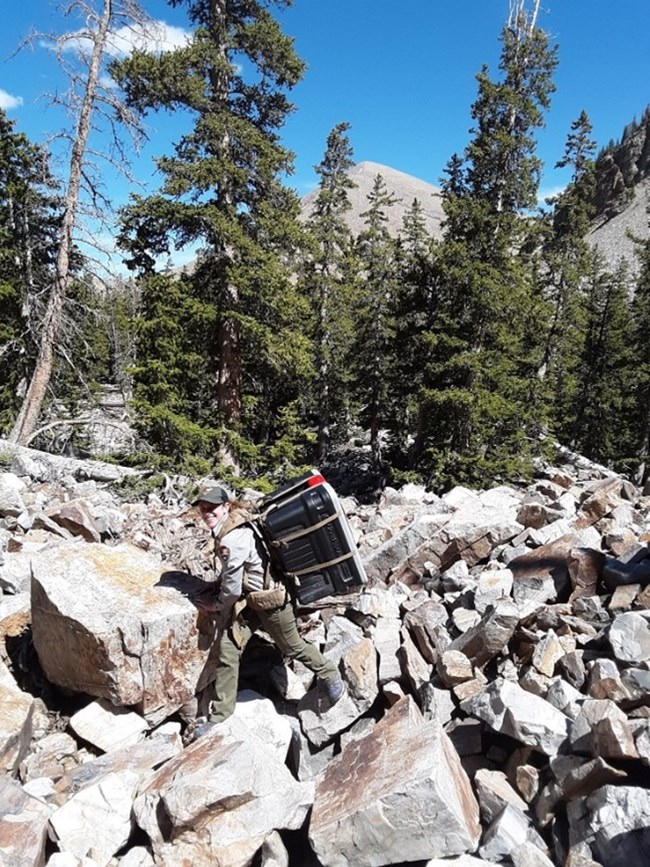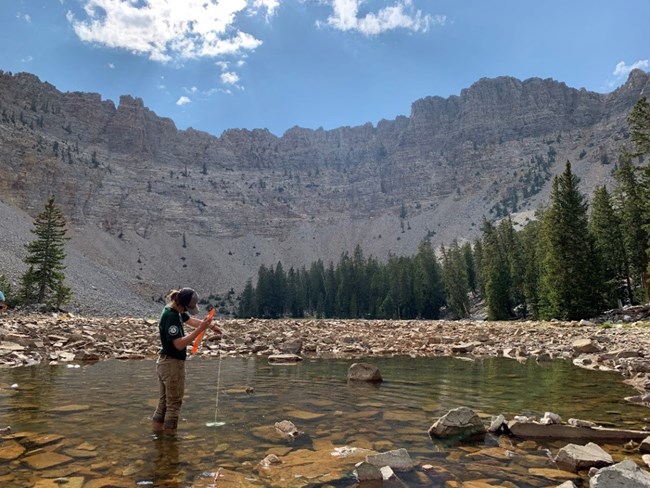Part of a series of articles titled The Midden - Great Basin National Park: Vol. 20, No. 2, Winter 2020.
Article
A Season of Change at Baker Lake
This article was originally published in The Midden – Great Basin National Park: Vol. 20, No. 2, Winter 2020.

NPS Photo by Jonathan Reynolds
Sitting at 10,620 feet and surrounded by a breathtaking cirque, Baker Lake remains a popular attraction for backpackers and day hikers visiting the park. From June through October, I was fortunate enough to be able to spend time working and camping at Baker Lake. I got to know the intricacies of this lake and the ecosystem it supports. Throughout the season we collected a wide variety of data to give us a better understanding of Baker Lake and the population of trout it currently supports.
Baker Lake is currently home to a healthy population of Brook Trout and Lahontan Cutthroat Trout. These fish are not native to the park and were stocked in the lake before the area became a national park. In September, we introduced native Bonneville Cutthroat Trout (BCT) into neighboring Johnson Lake. In the years to come, we hope to also introduce BCT into Baker Lake and create a new, thriving population of native trout for future generations to enjoy. A large part of our work this season has been preparing Baker Lake to be treated with the piscicide rotenone in the summer of 2021. Treating the lake with rotenone will allow the park to remove all nonnative fish before BCT are introduced.

NPS Photo by Jonathan Reynolds
Our first step in preparing Baker Lake for next year’s treatment was to perform snorkel surveys throughout the lake to document successful spawning of Lahontan Cutthroat Trout. Our first few trips up to Baker Lake, we put as much gear as we could carry on our backs and made our way up the trail to the lake. Once we arrived at the lake, we put on dry suits and snorkels and started the process of observing the fish in the lake. Our hope is that if Lahontan Cutthroat Trout are successfully reproducing, this is a good sign that Bonneville Cutthroat Trout will also be able to reproduce and create a self-sustaining population. When snorkeling in the lake, we were able to document what we believe is spawning behavior.

Stephanie Greenwood
In order to measure the lake and get a profile of the lake depth, we conducted a bathymetric survey with the help of the women’s Nevada Conservation Corps (NCC) crew. The survey involved creating a 5m x 5m grid in the lake and taking depth measurements every 5 meters. This tells us how deep the lake is and how much water is in it.
We also picked multiple reference points to measure their distance to the water. Then, when the water levels are higher, we can compare measurements using those reference points and extrapolate that change to the rest of the lake. This information gives us a better idea of how to properly prepare for the rotenone treatment and guarantee its success. Once the nonnative fish have been removed from the lake, Bonneville Cutthroat Trout will be reintroduced in order to create a new population that will hopefully be more resilient to survive a changing climate in years to come.
Last updated: February 7, 2024
